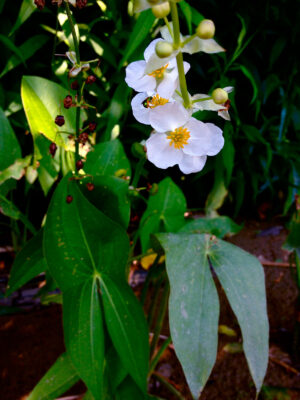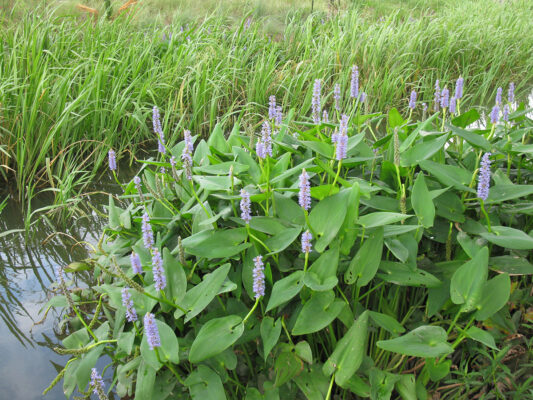The New Blossoming of San Pedro Creek
English
Español
-
The San Pedro Creek Culture Park project has reintroduced aquatic plants that once grew here but disappeared as urban development impacted the creek beginning in the 1800s.
Though it was necessary to build the creek channel of concrete to retain its flood-carrying capacity, protective pockets were built into the creek edges and hardy aquatic species were planted there.
These plantings provide natural water filtration and help treat pollutants—including sediment, metals, oil, and excess nutrients—that still enter the creek. They also provide urban wildlife with food and shelter. Fish, birds, turtles, frogs, snakes, insects, and human beings all benefit.

Photo: Fritz Flohr Reynolds; Courtesy: Creative Commons (CC BY-SA 3.0). Broadleaf Arrowhead (Sagittaria latifolia):
Arrow-shaped leaves and bright white flowers help identify this aquatic plant. Native Americans valued this nutritious food source whose starch-rich tubers form on rhizomes buried in the mud. Ducks also feed on them, giving rise to the nickname “duck potatoes.”
Source: San Antonio River Authority. Pickerelweed (Pontederia cordata):
The purple flowers of this aquatic plant bloom progressively upward and provide nectar to bees and butterflies. The seeds are eaten by ducks and other waterfowl. Pickerelweed excels at removing excess nutrients and other pollutants from the water. -
El proyecto del parque cultural San Pedro Creek reintrodujo plantas acuáticas que antaño crecían aquí, pero desaparecieron por el impacto del desarrollo urbano en el arroyo a partir del siglo XIX.
Aunque fue necesario construir el canal del arroyo con concreto para conservar su capacidad de carga de inundaciones, se construyeron bolsillos de protección en los bordes del arroyo y se plantaron especies acuáticas resistentes.
Estas plantaciones proporcionan una filtración natural del agua y ayudan a tratar los contaminantes—como los sedimentos, los metales, el aceite y el exceso de nutrientes—que todavía ingresan en el arroyo. También proporcionan alimento y refugio a la fauna urbana. Así se benefician los peces, los pájaros, las tortugas, las ranas, las serpientes, los insectos y los seres humanos.

Photo: Fritz Flohr Reynolds; Courtesy: Creative Commons (CC BY-SA 3.0). Punta de Flecha de Hoja Ancha (Sagittaria latifolia):
Las hojas en forma de flecha y las flores blancas brillantes ayudan a identificar esta planta acuática. Los nativos americanos valoraban esta fuente de alimento nutritivo cuyos tubérculos, ricos en almidón, se forman en rizomas enterrados en el barro. Los patos también los comen, dando lugar al apodo de “papa de pato”.
Source: San Antonio River Authority. Espigas de agua (Pontederia cordata):
Las flores púrpuras de esta planta acuática florecen de forma progresiva hacia arriba y proporcionan néctar a abejas y mariposas. Los patos y otras aves acuáticas se comen sus semillas. Las espigas de agua son excelentes para eliminar el exceso de nutrientes y otros contaminantes del agua.



